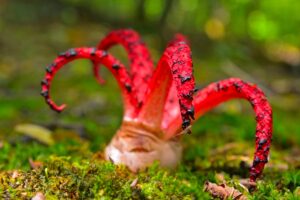Introduction:
Clathrusruber, also known as the Latticed Stinkhorn or the Basket Stinkhorn, is a unique and fascinating fungus that belongs to the Phallaceae family. It is native to Europe but has been introduced to other regions, including North and South America, Asia, and Africa. This blog post will explore the appearance and characteristics of Clathrusruber, its habitat, and distribution, its importance and uses, and some interesting facts about this fascinating fungus. We will also provide tips on how to find and observe Clathrusruber in nature.
Appearance and Characteristics:
Clathrusruber has a distinctive appearance, with a round, white egg-like structure that contains the immature fruiting body. As the fruiting body develops, it transforms into a reddish to bright orange cage-like structure that is bell-shaped and has a lattice-like structure, giving it the common names “Latticed Stinkhorn” and “Basket Stinkhorn.” The arms of the lattice-like structure are connected at the top, enclosing the inner portion of the fruiting body that contains the spores. Clathrusruber is known for its pungent odor, which has been described as similar to that of rotting meat and is thought to attract insects for spore dispersal.
Habitat and Distribution:
Clathrusruber is typically found growing in leaf litter or soil, often in gardens, woods, or other damp and shady areas. It is saprobic, meaning it feeds on decaying organic matter. Clathrusruber is native to Europe but has been introduced to other regions, including North and South America, Asia, and Africa. In some cases, it may compete with native fungi for resources and negatively impact the local ecosystem.
Importance and Uses:
Clathrusruber is not commonly consumed due to its foul odor and potential toxicity. However, it has been used in traditional medicine for its anti-inflammatory and anti-tumor properties. In addition, Clathrusruber is of interest to researchers studying the genetics and evolution of fungi.
Interesting Facts:
Clathrusruber is sometimes called “Devil’s Fingers” or “Octopus Stinkhorn” due to its unique appearance and odor.

The spores of Clathrusruber are distributed by insects, which are attracted to its pungent odor.
Clathrusruber is an invasive species in some regions and may negatively impact native fungi.
How to Observe Clathrusruber in Nature:
1: Identify its preferred environment: Clathrusruber is commonly found in damp and shady areas, such as gardens, woods, and leaf litter. Look for it in these types of environments, especially after rain or during damp conditions.
2: Look for its distinctive appearance: Clathrusruber has a unique appearance, with a round, white egg-like structure that contains the immature fruiting body. The mature fruiting body is bell-shaped with a lattice-like structure and bright reddish-orange color.
3: Follow your nose: The fungus has a pungent odor, often described as similar to rotting meat. This odor helps attract insects, which can aid in spore dispersal.
4: Be patient: Clathrusruber can take several days or weeks to fully mature, so be patient and visit the same spot regularly to observe its growth.
5: Handle with care: Clathrusruber is not edible and is considered poisonous, so it should not be touched or ingested. Wear gloves if handling and avoid touching your face or eyes after touching the fungus.
By following these steps, you can increase your chances of observing Clathrusruber in nature and appreciate its unique and striking appearance. Remember to always observe from a respectful distance and not disturb the natural environment.




Pingback: Alarming Surge of Leprosy Cases in Florida and Southeast US